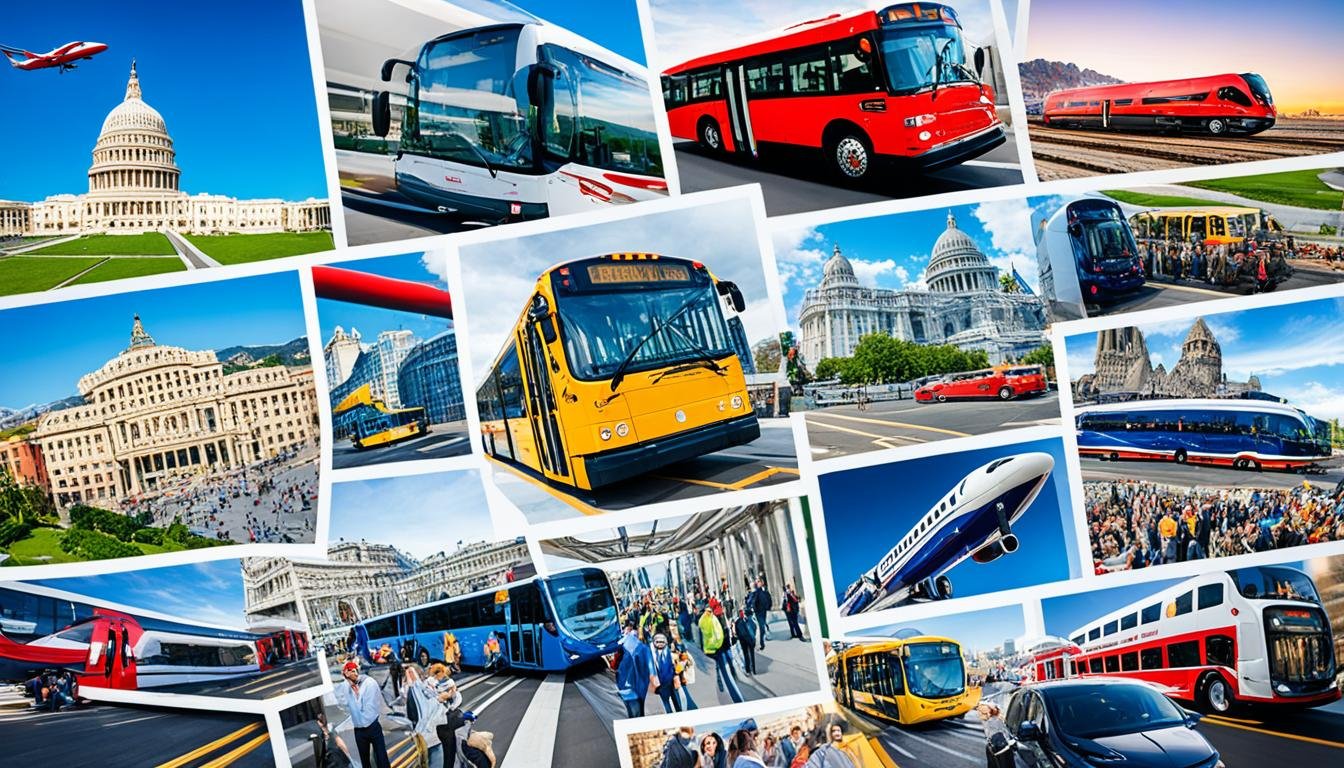Destination Management Essentials | Intro Guide
Picture this: you’re planning a trip to a beautiful coastal town. You’re excited to see the beaches, try the local food, and experience the busy culture. As you start your research, looking into where to stay and what to do, you’re really diving into what makes a destination special.
Our guide here will take you through all the important parts of managing a spot people want to visit. We’ll look at how to plan well and market wisely, so the place stays great for a long time. Sustainable efforts and making sure visitors feel welcome are key. They help in building places everyone will remember.
Ready to dive in with us? We’ll talk about the main ideas in managing a place people love to visit. This includes learning how tourism affects spots, ways to attract guests, sustainable actions, and smart planning to develop cool places. Plus, we’ll highlight the important job of DMOs and go over the tricky parts and future changes in this field.
Key Takeaways:
- Introduction to destination management and its core elements.
- Understanding the impacts of tourism on destinations.
- Effective destination marketing and promotion strategies.
- The importance of sustainable tourism management practices.
- The role of destination planning and development in creating successful destinations.
Defining Tourism Destination Management
A tourism destination is where people stay overnight. It includes things that make it attractive to visitors. This includes products, services, attractions, and resources. Knowing these elements helps in managing a destination well.
The main focus is the experience visitors get at a destination. Tourists want to explore, learn about local life, or have fun. Items like hotels and tours meet their needs and make their trip better.
Support services are key in making visitors happy. These include transportation, places to stay, eat, and fun things to do. They make a big difference in visitors’ satisfaction and coming back again.
Attractions are vital for drawing people in. They can be historical, natural, cultural, or fun places like theme parks. These things make a destination stand out and attract tourists.
Resources
Resource use is crucial in destination management. This includes nature, like forests, and local people’s skills. Managers must use these wisely for sustainable tourism growth.
Destination managers must understand all parts of a destination to make it work well. They find what makes it unique. Then, they use attractions and resources to create great experiences. This brings in more visitors and helps the area grow.
The Impacts of Tourism on Destination
Tourism is growing fast around the world. It affects a location’s people, money, and nature. These effects can be good or bad, influencing our lives in many ways.
Social Impacts:
One big part of tourism is sharing different cultures. When visitors and locals meet, they learn about each other’s ways. This sharing can boost our understanding of others and grow respect.
Tourism also helps keep local traditions alive. Events, crafts, and dance performances become important because tourists love them. This keeps the culture from fading and helps local people earn money.
Economic Impacts:
Tourism is vital for many places’ economies. It creates jobs and brings in money. People get work in hotels, transport, and fun spots. The need for more products and services helps local shops.
Money from tourism can help a place build better. It might improve roads, hospitals, and schools. This makes life better for both visitors and locals.
Environmental Impacts:
But tourism’s effect on the planet is worrisome. More visitors means more energy used, water wasted, and trash made. Too many people in one place can harm nature and wildlife.
There are ways to do better, like green hotels and telling guests to protect the environment. It’s important that we travel in ways that don’t hurt our planet.
It’s key for those in charge of destinations to understand tourism. They need to look at the big picture and come up with ways to have good impacts and less bad ones. Green tourism is the future for our destinations to thrive and last.
Destination Marketing and Promotion
In today’s world, strong marketing and promotion are key for drawing tourists and increasing income. Destination managers use innovative strategies and a firm brand to attract visitors. They become leaders in the worldwide tourism market.
Marketing for a destination involves making strategies that fit its unique traits. These strategies showcase what makes the place special and create a brand that speaks to the right people. This way, the destination catches the eye of potential visitors.
Sarah Johnson, an expert in this field, says “Destination marketing is about more than just showing off a place. It’s about making tourists feel connected and excited to visit.” She says that by telling stories and sharing inspiring pictures, marketers can make people want to explore these places more.
It’s also important to market to specific groups. Destinations aim their efforts at different types of travelers by knowing their likes and habits. For instance, a beach spot might focus on families, while an adventurous place would attract those who love thrill-based activities.
Jessica Martinez, a well-known travel voice, also points this out. She says, “I’m drawn to places that match what I love, like great food or adventure. When a destination shows they have what I’m looking for, I get more interested in visiting.”
To reach more tourists, destinations use various platforms. These include social media, websites, blogs, and being featured by influencers. Using many channels helps destinations get attention from a broad group of people.
Destination marketing changes as people start using digital tools more. Travelers often find their next trip online. This has made it critical for destinations to offer virtual tours and interactive content, among other things.
Now, travelers also care deeply about not harming the environment. This has led to a focus on eco-friendly and socially responsible marketing. By showing their green efforts, destinations can attract these mindful visitors.
Destination Marketing and Promotion Checklist:
- Create marketing that highlights what makes the destination special.
- Build a brand that appeals to your target audiences.
- Dive into the needs and wants of different traveler groups.
- Use many marketing channels to reach a broad audience.
- Keep up with changes in how people use technology to plan their trips.
- Focus on promoting sustainability in your destination.
By using smart marketing, destinations can do well in the competitive tourism scene. They attract visitors who match their unique vibes. This helps in the long run for the destination’s growth and success.
Sustainable Tourism Management
Sustainable tourism management is crucial for destination viability. It uses sustainable methods to reduce negative environmental tourism effects. This includes conservation efforts to protect nature for future generations.
It also focuses on environmental conservation. This means preserving ecosystems, protecting wildlife, and lessening pollution. Destinations are encouraged to use eco-friendly and renewable energy to be more environmentally friendly in tourism.
Engaging local communities is key for sustainable tourism. Supporting their growth creates a sense of pride. This ensures tourism improves the lives of locals and supports their well-being.
Effective management includes everyone involved, like tourists and officials. It requires teamwork to promote sustainable and responsible tourism. This way, balance between economic growth, environmental care, and social support can be achieved.
“Sustainable tourism is about more than nature preservation. It’s also about sustaining culture and improving locals’ lives. It’s ensuring the place’s lasting vitality.” – Sustainable Travel International
By choosing sustainable practices, destinations offer unique experiences and preserve their heritage. This management is both ethical and a path to success in a changing world.
Benefits of Sustainable Tourism Management
Sustainable tourism has several advantages for destinations, locals, and visitors:
- It preserves natural resources and wildlife.
- It boosts the economy by creating jobs and generating income.
- It celebrates and protects cultural traditions.
- It enhances the life quality of those living there.
- It offers visitors genuine and enriching experiences.
Adopting these practices allows destinations to make a lasting, positive impact on their environment and those who live there.
Destination Planning and Development
Creating successful tourism destinations requires careful planning and development. Destination managers focus on making the experience great for visitors. This means looking at what infrastructure is needed, talking to local groups, and making sure there are good ways to get around, places to stay, and things to do.
Strategic Planning for Destination Success
Strategic planning guides the growth of tourist spots. It starts with a vision and clear goals. Managers draw a map for success, looking at trends, choosing who to attract, and how to tell them about the place.
Infrastructure Development for Visitor Convenience
Making sure there’s the right physical setup is key. Building up transport, places to stay, and fun things to do makes the trip smooth and enjoyable. Great infrastructure keeps visitors happy.
Engaging Stakeholders to Foster Collaboration
Involving those who care about the place builds its character and makes the experience unique. Such as locals, officials, and tourism groups. Getting their views means everyone’s needs are met. It leads to new ideas and everyone feeling they own the project’s success.
| Benefits of Destination Planning and Development | Effective Strategies for Destination Planning and Development |
|---|---|
| Enhances the overall visitor experience | – Conduct thorough market research |
| Boosts the destination’s competitiveness | – Define clear goals and objectives |
| Attracts a diverse range of visitors | – Engage with stakeholders throughout the process |
| Generates economic growth and job opportunities | – Invest in sustainable and responsible tourism practices |
| Preserves and highlights the destination’s unique attractions | – Continuously evaluate and adapt the destination’s offerings |
Overall, focusing on destination planning and development is key to managing a place well. Strategic thinking, building necessary set-ups, and teamwork ensures visitors remember their trip fondly. It also means the place can keep delighting guests for a long time.
Visitor Management

Visitor management is essential for any destination to run smoothly. It helps tourists have a great time and keeps the place nice for others. By using different techniques, managers can improve the destination and make visitors happy.
Crowd control is a major part of managing visitors. It means using plans and tools to handle many people. By guiding how visitors move around and spreading them out, the place stays welcoming for all.
Determining how many visitors a place can handle is also key. This is known as carrying capacity. It’s the most visitors a place can support without harming nature or culture. Sticking to these limits helps keep the place special and safe.
Ensuring visitors are happy is critical. Managers listen to what visitors say to understand their wants and needs. They then use this feedback to improve. Happy visitors are likely to come back and tell others about the place.
“Proper visitor management techniques ensure a positive and enjoyable experience for tourists while minimizing negative impacts on the destination.”
Good visitor management is vital for preserving and enjoying destinations. By keeping track of the crowds, limiting how many visitors come, and focusing on what visitors need, these managers make unforgettable experiences for everyone.
Visitor Management Techniques
Here are some common ways managers handle visitors:
- Advance ticketing and timed entry: This method limits the number of people at one time, making it easier to manage everyone.
- Visitor information centers: These places give visitors helpful info about the area and any rules they have to follow.
- Interactive maps and signage: Signs and maps help visitors find their way, making the visit smooth and enjoyable.
- Education and awareness programs: These programs teach visitors to be mindful of the environment and the local culture, promoting responsible tourism.
Using these methods and checking how well they work, managers can keep a delicate balance between welcoming visitors and protecting the place’s natural and cultural treasures.
Destination Management Organization
Destination Management Organizations (DMOs) are crucial in managing and promoting tourist spots. They take the lead in marketing, developing, and organizing activities in a place. DMOs work with governments, local groups, and tourism companies to make destinations thrive.
DMOs focus on promoting the area. They use special marketing plans to pull in visitors and show off what makes the spot unique. This includes its sights, history, scenery, and events that draw in tourists.
DMOs play a crucial role in destination marketing by presenting an accurate and appealing image of the destination to potential visitors.
DMOs also help in making places better for visitors. They team up with others to spot chances for growing things like roads and services. This way, they help make visiting better while aiding in the spot’s lasting growth.
Working together is key for DMOs. They unite with many to set a clear vision and plan for a spot. With this teamwork, they can use their skills and resources to hit shared targets.
Role of DMOs
DMOs do more than just market. They give tips, do research, and aid tourist and local businesses. They also gather and share info that helps a place grow and get better.
- Facilitate destination planning and strategy development
- Provide market research and analysis
- Offer business support and training
- Promote responsible and sustainable tourism practices
- Advocate for the destination’s interests at a regional, national, and international level
Managing a spot is complex for DMOs. They balance the needs of tourists, locals, and nature. This ensures the area does well for everyone, including the environment.
Collaborative Tourism Promotion
Good tourism promotion needs teamwork. DMOs, locals, and businesses work together to impress visitors with a spot’s beauty and culture.
Collaboration is key to successful destination promotion. The collective efforts of DMOs and their partners can create a compelling narrative that captures the essence of the destination.
DMOs use many ways to spread the word, like online and at events. They also make ads, videos, and websites that show what’s great about a place.
Example Destination Management Organization: VisitScotland
VisitScotland is a great example of a DMO. It promotes Scotland all over the world. Through clever marketing, joining forces with others, and making Scotland better for visitors, it’s turned Scotland into a top choice for many.
| DMO Activities | Role |
|---|---|
| Destination marketing | Promoting the destination, attracting visitors, creating brand awareness |
| Collaboration | Working with stakeholders, government bodies, and local communities |
| Destination development | Identifying infrastructure needs, enhancing tourist experiences |
| Market research | Conducting research, analyzing market trends and visitor demand |
| Sustainable tourism practices | Promoting responsible tourism practices, environmental conservation |
Challenges and Future Trends in Destination Management
Managing destinations is tricky and full of hurdles. Destination managers tackle many issues daily, demanding quick, clever solutions in the face of tourism’s constant shifts. It’s vital that they also keep up with upcoming trends for sustained success. We’ll dive into the main challenges and future directions in this field.
Challenges in Destination Management
One big challenge is handling over-tourism. Places that are very popular can get too crowded. This crowds out locals, harms nature, and leaves visitors unhappy. Finding new ways to cope with over-tourism is a must for managers.
Technological progress also brings its own set of issues. While tech has improved tourism, it can shake up how places are managed. Staying on top of these changes, from new apps to smart devices, is essential. This shift provides a chance to make the tourist experience better and to market destinations more efficiently.
Then there are the changing habits of travelers. People now want real and green adventures, and they look for trips that match their values. Managers must tweak what they offer to meet these fresh expectations. This means pushing local culture and eco-friendly tourism.
Future Trends in Destination Management
Looking forward, sustainability stands out as a top trend. Tourists want green places and practices. By going eco-friendly and supporting local communities, destinations can attract these mindful travelers.
Technology is another force shaping the future. Things like AI and VR can really change how we plan trips and market places. In this digital age, being tech-savvy is key to drawing in tourists. But, remembering a place’s history and charm is still vital.
Personalized trips are also on the rise. Thanks to data, managers can offer visitors suited-to-them experiences. Custom plans and unique activities will make journeys unforgettable. Knowing what travelers want and using digital insights well is the recipe for success in this area.
In summary, managing destinations is a constant balancing act with trends and challenges. Tackling over-tourism, taking on new tech, and meeting changing traveler needs are crucial steps. Success lies in being ready and flexible to face these shifts head-on.
Conclusion
Destination management covers many areas like planning and marketing. It also looks at how to keep places sustainable. Knowing these helps managers make tourism spots successful and lasting.
Working together and keeping up with trends is key. This way, managers can use the best ideas and resources to help spots grow. They also need to watch new technologies and what customers like. This helps them make changes to offer great experiences.
The main goal of destination management is making visitors happy. When managers focus on what tourists need, they create trips that people love. This encourages visitors to come back and tell others about their great time. This guide highlights the important points about destination management. It shows what’s needed for success in this lively area.







